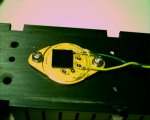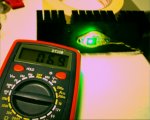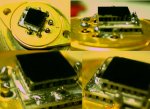HIMNL9
0
- Joined
- May 26, 2009
- Messages
- 5,318
- Points
- 0
As in the title ..... in the past, i already experimented with TEC's, with the idea to get some decent (and cheap) sensor for laser power metes, without have to use thermopiles ..... but never got too much good results, cause, mainly, the old type TEC's was too big, and the thermal conductivity of a TEC unit is intrinsecally too high ..... then i got "real" ones, and left the idea vanish.
Recently, i got a pair of working TEC plates from Heruur, mounted on TO3 style bases, and my DIY maniac part woked up and got the feeling to restart some experiment.
and got the feeling to restart some experiment.
First trial, just painted AR black the surface of a 10x10mm one, and stuck it on a heatsink (first pic) ..... stabilization time is still too high for a fast response meter, cause it still take approximatively 15 seconds for stabilize (old ones was around 30 seconds), but the output is a decent amount, also if the sensitivity is not extremely high (it start to read only over 14 / 15 mW) ..... anyway, as you can see in the second pic, it give me almost 7 mV for a 50 mW module (emitting 44 mW), so a simple op amp can take care of it.
But doing different tests, i noticed that it's too much sensitive to air temperature, and that, also with all that heatsink mass, it transfer too much to the "cold" face, deriving too much for long or repeated reading (the reading in the pic is after 20 cycles of 30 seconds from the 44mW module, where at the first reading it was 7,6mV) ..... i also tried using a beamsplitter and the LPM, in conjunction with it, and the 150mW module on the heatsink, with half of the beam on the LPM and half on the TEC ..... keeping the beam for 120 seconds on, after thermal stabilization, and taking readings on LPM each 10 seconds, the LPM was deriving just 4%, where the TEC was deriving almost 30% ..... that was not completely unexpected, cause, after all, TECs are extremely efficent heat transfer plates, when not powered ..... but was anyway more of the expected.
Then i had a crazy idea ..... took my last 8x8mm TEC plate, and soldered it over the 10x10mm TEC that is on the TO3 plate (was both gold plated, and i used some indium alloy, for not risk to melt the junction connections, but was a hell of work the same ) ..... and also soldered a smd NTC chip on the plate of the bigger TEC (pic 3).
) ..... and also soldered a smd NTC chip on the plate of the bigger TEC (pic 3).
My idea is to use the lower tec for keep the "cold" side of the upper one stabilized at a fixed temperature (was planning 18 C or similar, for not have to use too much power) using the NTC as sensor and feedback for a PWM circuit, and enclose the assembly in something that repair it from air currents ..... at this point, the upper TEC must be much more precise and stable in reading
Still developing the circuit and finishing the painting of the "reading face", anyway, but an on-the-fly test, gave me some encouraging result ..... after thermal stabilization at 20 C, as example, the upper TEC was starting to read something with a 9mW module, took 11 seconds for stabilize with the 44mW one, and 14 seconds for stabilize with the 144mW one ..... and remained "almost" stable also after a pair of minutes (almost, cause the driving circuit for the lower TEC is still not perfect, so it have a bit of delay in reaction and a little derive, almost 3% in temperature ..... still experimenting, anyway)
Well, i'm working on it only in the free time, so don't expect all the schematics ready and published for tomorrow, nor keep the breath waiting ..... but, seeing that there was some encouraging results, i've thought to share this, at this point ..... when i get better results, i update this one, and who know, maybe in the meantime also others can have some good ideas in the same direction and share them, too
..... but, seeing that there was some encouraging results, i've thought to share this, at this point ..... when i get better results, i update this one, and who know, maybe in the meantime also others can have some good ideas in the same direction and share them, too 
BTW, i've seen that heruur have on ebay some very small TECs, like 6x6mm ..... ofcourse, using small ones, there are less junctions, so there's also less output voltage, but i'm wondering about what the response time of a plate so small can be, compared to my 8x8mm one (after all, 8x8 is 64 square millimeters, where 6x6mm are just 36 square millimeters, and also if the ceramic plates are the same thickness, the thermal mass must be almost the half
 )
)
Recently, i got a pair of working TEC plates from Heruur, mounted on TO3 style bases, and my DIY maniac part woked up
First trial, just painted AR black the surface of a 10x10mm one, and stuck it on a heatsink (first pic) ..... stabilization time is still too high for a fast response meter, cause it still take approximatively 15 seconds for stabilize (old ones was around 30 seconds), but the output is a decent amount, also if the sensitivity is not extremely high (it start to read only over 14 / 15 mW) ..... anyway, as you can see in the second pic, it give me almost 7 mV for a 50 mW module (emitting 44 mW), so a simple op amp can take care of it.
But doing different tests, i noticed that it's too much sensitive to air temperature, and that, also with all that heatsink mass, it transfer too much to the "cold" face, deriving too much for long or repeated reading (the reading in the pic is after 20 cycles of 30 seconds from the 44mW module, where at the first reading it was 7,6mV) ..... i also tried using a beamsplitter and the LPM, in conjunction with it, and the 150mW module on the heatsink, with half of the beam on the LPM and half on the TEC ..... keeping the beam for 120 seconds on, after thermal stabilization, and taking readings on LPM each 10 seconds, the LPM was deriving just 4%, where the TEC was deriving almost 30% ..... that was not completely unexpected, cause, after all, TECs are extremely efficent heat transfer plates, when not powered ..... but was anyway more of the expected.
Then i had a crazy idea ..... took my last 8x8mm TEC plate, and soldered it over the 10x10mm TEC that is on the TO3 plate (was both gold plated, and i used some indium alloy, for not risk to melt the junction connections, but was a hell of work the same
My idea is to use the lower tec for keep the "cold" side of the upper one stabilized at a fixed temperature (was planning 18 C or similar, for not have to use too much power) using the NTC as sensor and feedback for a PWM circuit, and enclose the assembly in something that repair it from air currents ..... at this point, the upper TEC must be much more precise and stable in reading
Still developing the circuit and finishing the painting of the "reading face", anyway, but an on-the-fly test, gave me some encouraging result ..... after thermal stabilization at 20 C, as example, the upper TEC was starting to read something with a 9mW module, took 11 seconds for stabilize with the 44mW one, and 14 seconds for stabilize with the 144mW one ..... and remained "almost" stable also after a pair of minutes (almost, cause the driving circuit for the lower TEC is still not perfect, so it have a bit of delay in reaction and a little derive, almost 3% in temperature ..... still experimenting, anyway)
Well, i'm working on it only in the free time, so don't expect all the schematics ready and published for tomorrow, nor keep the breath waiting
BTW, i've seen that heruur have on ebay some very small TECs, like 6x6mm ..... ofcourse, using small ones, there are less junctions, so there's also less output voltage, but i'm wondering about what the response time of a plate so small can be, compared to my 8x8mm one (after all, 8x8 is 64 square millimeters, where 6x6mm are just 36 square millimeters, and also if the ceramic plates are the same thickness, the thermal mass must be almost the half
Attachments
Last edited:






